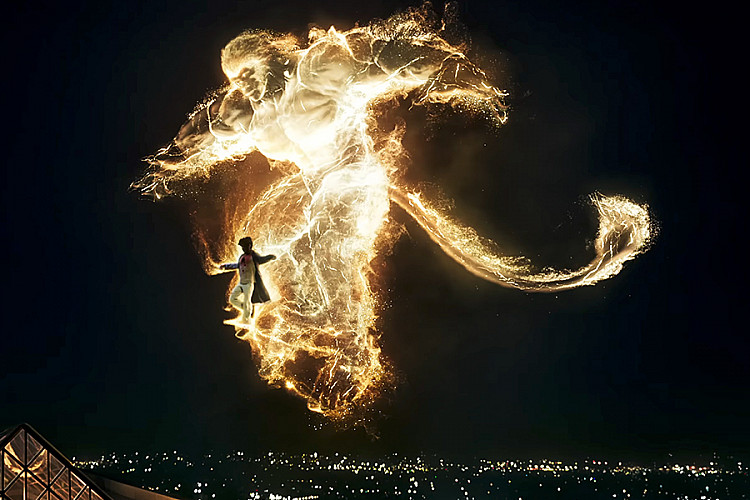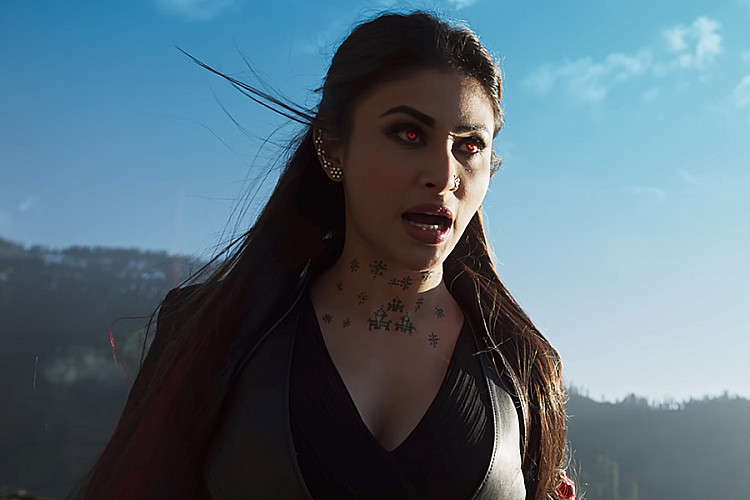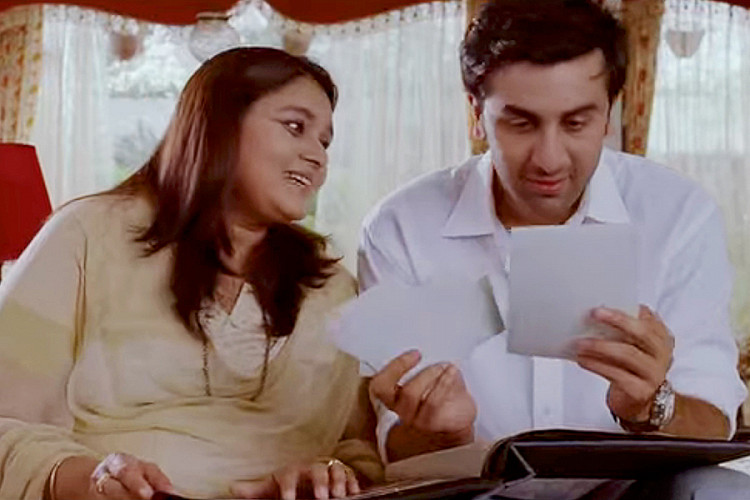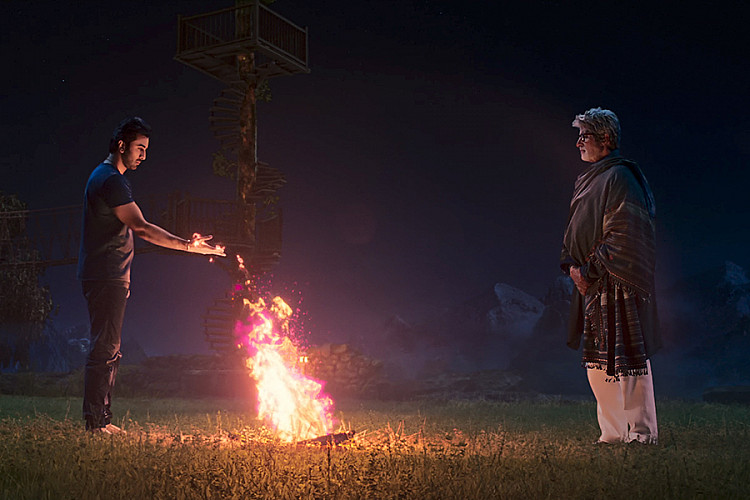
[ad_1]
Text by Prathyush Parasuraman.
One of the first glimpses of Brahmastra Part One: Shiva we had, the announcement of its motion poster launch, was in Hindi, so archaic and untouched by the contemporary, that it could only be understood in context. The voice was that of Amitabh Bachchan; pay attention to how it traverses the clash of consonant sounds without any vowel’s reprieve — the “gn” of “agni”, the “str” of “brahmastra” — how it digs into the epiglottal “kh” of “khud” and releases the last “ah” in ”Shiva” as though freeing something fettered. Director Ayan Mukerji wrote on Instagram, “Mr. B’s voice — had to start with his energy and his blessing!”
There was nothing playful or charming about this Hindi — the kind used to introduce the world of Brahmastra. It was sombre, joyless and respectable. You did not have fun repeating it, and you did not want to repeat it. In the first part of the trilogy’s world-building, where Bachchan both introduces this mythical world and plays an integral part in it — as Guru, who mentors Shiva (Ranbir Kapoor) — there is now a tension between English and Hindi, Hindi and Urdu, one that is located in the film’s acquiescent politics of language. I use the word “acquiescent” because this film is not actively propagating something suspicious, for it is not even remotely interested in being political as much as it is in being commercial.

Mukerji is a lover of Bombay cinema, and this is clear in his pulling Bachchan and his baritone into the film, along with Shah Rukh Khan. The latter is in a cameo as scientist Mohan Bhargav — also the name of his character in Swades, a NASA Scientist. Mukerji, who was an assistant director on Swades, sees Brahmastra as building a bridge between contemporary Hindi cinema and that which came before it, acknowledging that whatever Bombay Cinema is today — the acid, the alta, the aggression, the affection — is part of a tapestry, and that there is nothing exceptional about this moment, that it hasn’t sprung forth from a vacuum. Meta context, a bubbling desire to be part of cinema’s broader story alongside the hubris of wanting to create cinema’s broader story, is built into the film. The questions to ask, then, are what is the film-maker tapping into, and what is he creating?
That language is political, there is no contention. That language is also coded, with meaning lurking in the subtext, cannot be contested either. So, when a film initially named Dragon, with its male protagonist, Rumi — over 11 years of stormy production and even stormier politics — is rechristened as Brahmastra, whose protagonist is now Shiva, more questions swarm. In 2018 — four years after Modi came to power and two years after producer Karan Johar had to apologise publicly for casting a Pakistani actor, Fawad Khan, in his film Ae Dil Hai Mushkil — Mukerji insisted, “We gave Ranbir a haircut, and Rumi became… Shiva.”
But is it that simple?

The film makes a gin-clear distinction between villainy and hero-hood, one that can be seen in not just the unsubtle visual imagery of Mouni Roy as the villain Junoon (always dressed in black, kohl spilt around her eyes) but also the language. “Junoon”, which means “passion” as well as “obsession”, is a word rooted in the Perso-Arabic tradition and pitted against the Sanskritic “kartavya” or “duty”, one that Shiva, his love interest Isha (Alia Bhatt) and Guru emphasise and embody. They are seen and spoken of as binaries. When Shiva refers to moral darkness, he uses the word “taakat” — and when the light of goodness is brought up, he says “shakti”. Both mean the same thing — “power” — but come with different cultural connotations. The former in Perso-Arabic and the latter in Sanskritic, and, thus, in this film, they inhabit different moral universes. We could complicate this aspect further by considering the tilt of Bombay Cinema away from Urdu, towards Hindi. As it is, this transition feels complete, with the former’s current presence a hollow, aesthetic gesture. Analysing songs from 1959 to 2010, Rizwan Ahmad, a sociolinguistics professor at Qatar University, has noted the gradual loss of Urdu sounds in Bollywood songs — the replacement of the uvular q with the velar k, for instance. So here, what is supposed to be “taaqat” has become “taakat”, and Urdu is simultaneously bled dry of its sounds and associated with violence and darkness.
It isn’t just the wreckage of Hindustani that Brahmastra partakes in, but the generous and awkward secretions of Hinglish, too. A question that needs to be asked — self-evident yet frequently forgotten — is whom the movie is made for, the answer to which clarifies a lot about the narrative choices that we might, otherwise, consider odd. The film, allegedly on a budget of more than INR 400 crores, is tactically made, lassoing talent from cine Telugu and television — Nagarjuna and Roy — to bring in an audience that wasn’t typically that of Hindi movies. They even got on director S.S. Rajamouli to “present” the film, and this included him eating a sadya meal alongside Kapoor and Nagarjuna in full view of the slobbering paparazzi during the promotions.
Johar’s attempt to court South India is not surprising. Its four states each have a throbbing relationship to cinema, inculcating a film culture that is just as egregious as it is enthusiastic, as tenacious as it is toxic. According to the Film Federation of India, these states have the highest number of single screens in the country: Andhra Pradesh and Telangana (2809), Tamil Nadu (1546), Kerala (1015), Uttar Pradesh (970) and Karnataka (950). The tickets to single screens are cheaper, and the whole expedition of cinema — public access, popcorn prices — is also more affordable than going to a multiplex. To think of film culture, we must also think of the economics that underpins it and allows it to flourish. The multiplex revolution of the early 2000s, which coincided with the rise of Johar’s NRI-tilted cinescape, seems to have withered its audience pull: he is now producing projects that can travel the cultural distance (like the sports-action film Liger and Brahmastra), getting these films and their music dubbed as accurately and compellingly as possible, and also experimenting with language, donning a new urban identity that is not so much interested in being relatable to metro-urban audiences as it is in being flashy and formative to the audiences beyond.
It is in this desire to reach out, to broaden the target audience, to more accurately produce success, that I am locating Brahmastra’s shock of English words. Isha — London-returned in back-story but with Bandra-reverb in detailing — says “click” to take a mental picture of a beautiful moment. The shape of the brahmastra (weapon) is described as a “pizza”. “Artist” and “scientist” are used so unsparingly to refer to artists and scientists that it seems as if there isn’t much more to them than their professions. “Light” and “button” pop up like unsuspecting weeds, out of place in the linguistic texture of a sentence, producing the same rush of agitation as when “love storiyan” was inserted smack in the middle of Kesariya, a typical, swooning love song with ornate and sentimental Hindi lyrics.
To casually move between Hindi and English without bringing attention to the liminal piece of land, this contested territory between them, is an art in and of itself. But this transition is something we’ve seen Mukerji be sympathetic to. In Wake Up Sid, his directorial debut with Dharma Productions, the mother of the titular character is a woman torn between the Hindi she spoke growing up and the English her son learnt growing up. He often mocks her club-footed attempts at infusing her sentences with English, and this endeavour to build a linguistic bridge between mother and son instead creates an emotional distance between the two. Brahmastra’s insistence on Hinglish, however, is different: while the former deployed it to deepen character, the latter intended for it to deepen, and widen, the audience.

In Mukerji’s second film, Yeh Jawaani Hai Deewani, he, along with his dialogue writer Hussain Dalal — who also wrote the dialogues for Brahmastra — took Hinglish to its effortless pinnacle. Pay attention to the linguistic swerves of this line: “Shaadi is dal-chawal for pachaas saal till you die” (Marriage is eating dal and rice for 50 years till you die). The nouns are mostly in Hindi, but the structure of the sentence toes the English syntax and the sentence ends with a noun, not a verb. Alternatively, in “Tu right nahin hai, Naina. Bas mujhse bohot alag hai” (You are not right, Naina. Just very different from me), the broad structure of the sentence is in Hindi but with English replacing the Hindi noun. This is not the utterance of a short-circuited mind that is grappling for a Hindi word in a Hindi sentence and replacing it with an English one because it was more within reach. The Hinglish of this film is a language unto itself, at ease with its transitions and with English vocabulary in a Hindi syntax or vice-versa. It is an exclusively metro-urban lingo, trying to replicate a world its makers knew and partook in, part of a robust narrative tradition that burst open in 1998 with Nagesh Kukunoor’s Hyderabad Blues, Kaizad Gustad’s Bombay Boys and Johar’s Kuch Kuch Hota Hai. It is a phenomenon with its gaze firmly fixed towards Tier 1 cities — the Hyderabads and Mumbais and Delhis and Chennais.
The fantasy epic’s concerted and forceful effort to glide towards Hinglish must be viewed in the context of Mukerji and Johar seeing cinema as an aspirational medium. I cannot imagine either of them — both anglophiles — nor dialogue writer Dalal thinking that these dialogues are smart or charming or poetic. It seemed that they had been relying on the extremely passive and extremely willing consumption of celebrities on and off the screen, designing a lexicon they believed would be lapped up by an impressionable audience that looks outwards to fashion an image of the self and gets caught up in the cultural tailwinds of cinema. So even Bachchan, who opened the film as a narrator with iron-clad Hindi, is, as Guru, forced to pulsate his sentences with the simplistic “switch on” and “switch off” to explain to Shiva that Isha is the switch that enables his power, that love catalyses strength.
To be clear, I am not suggesting that such an impressionable audience exists (though it might). I am saying that Johar, Mukerji and Dalal are definitely convinced that it does, have carved it as integral to their film’s reception, and they now make films exclusively keeping it in mind. Thus, in moving away from the usual and, till one point, reliable metro-urban audience that used to be Dharma Production’s foothold, Brahmastra makes its characters speak a language that neither the writer, nor the producer, nor the director has a grasp of. The Mumbai here is a city that is built as a polished, scaffolded set, and the urbanness in the language and detailing is painted using a generic palette. While geographic authenticity or linguistic punches (where is the “Bambaiyya”?) were never the forte of Dharma, with Brahmastra it seems like they stopped having fun with the opulence and excessiveness of their built-world. Instead, they want to be sincere in their outrageous world-building because it is no longer enough to only entertain. It is natural, then, for the film to emit an unstable, distorted energy — what it wants to say inflected by a self-conscious overthinking about whom it imagines it is saying this for.

Think of this dialogue, where Shiva is explaining his philosophy of looking at the brighter side of things to Isha: “Light uss roshni ka naam hai. Jo hum sabke andheron se badi hai” (Light is the name of the brightness that is bigger than any of our darknesses). “Light” and “roshni”, despite meaning the same thing, connote different registers of thought entirely. While roshni is an unsuspecting noun, a Hindi word of Persian origin, something familiar and casual, “light” is supposed to be a concept that the film introduces, a cosmic idea, an arrow in the accessible quiver of self-help vocabulary. The single crisp syllable in English is meant to add a sheen of aspiration, similar to Rajkumar Hirani’s now-iconic and easily quotable “All is well” mantra from 3 Idiots. Unlike “All is well’, however, there is no winking joy or naive idealism in Shiva’s platitude, just a cloying sincerity. And, unlike in Yeh Jawaani Hai Deewani, the Hinglish here stinks of the desperate need to become a part of the viewer’s cultural vocabulary.
According to the 2011 Census, a little over 10 per cent of Indians can speak some English, making it the second-most widely spoken language in India, after Hindi. There is a clear rural-urban, male-female, rich-poor, upper caste-lower caste divide in this. It is also, as data journalist Rukmini S notes, the only language that more speakers use as their second rather than their first, “pointing to its growing value in work environments and its role as a bridge language”. By pitching the film in the direction of the 90 per cent, the makers of Brahmastra are hoping it would yield something novel for them. Take for example how, in the past year, all Dharma Productions releases were introduced in both the Roman and Devanagari scripts in the credits. Even a film like Gehraiyaan, which may have seemed exclusively tailored for an urban audience, scribed its title and all its actors in both Hindi and English — a strategy that was absent in films from just a few years before it, like Gunjan Saxena and Shershaah. This is a recent shift, post the pandemic’s opening up of cinemas, post the worrying but also slightly comical onslaught of boycott campaigns (an entirely North Indian phenomenon).
The preoccupation with seeming contemporary, to seem urban and be collar-up cool while tapping violently into traditions (like Isha, who is shown to be as comfortable in a sari as in a dress, in a disco as much as a Durga pandal) modulates this modernity. To be rooted and religious even as you fling yourself at the urban revolution, to be comfortable in the world of myth and ritual that constrains — as much as in spaces of alleged freedom — to linger between these worlds as though there were not any seams, any tension, is possible only because the film shuns politics. The bigoted politics of religion. The alienation of modernity. It is why these gestures of aspiration the film tosses at us might appear alluring but are, ultimately, empty.
[ad_2]
Source link

